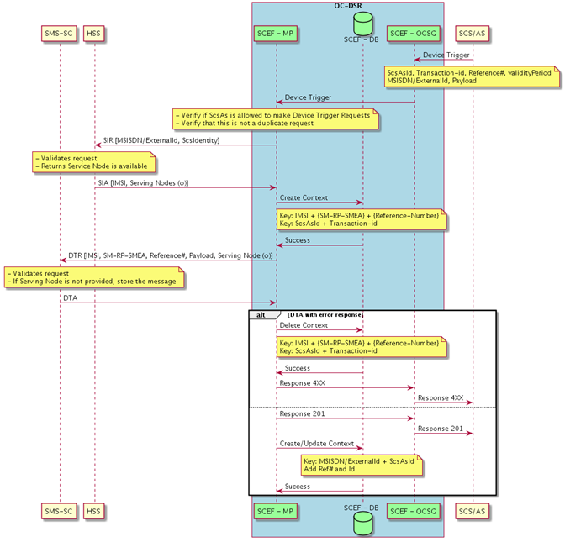| Oracle® Communications Diameter Signaling Router Service Capability Exposure Function User's Guide Release 8.4 F12301-02 |
|
 Previous |
 Next |
| Oracle® Communications Diameter Signaling Router Service Capability Exposure Function User's Guide Release 8.4 F12301-02 |
|
 Previous |
 Next |
Figure 2-16 Device Triggering Transaction Creation

Note:
SCEF always gives higher preference to the External Identifier when both Identifiers (External Identifier and MSISDN) are present in the Device Triggering Transaction Request message.DSR SCEF stores the External Identifier or MSISDN, SCS/AS Identifier, Destination Address, and Validity Period. If the SCS/AS is not authorized to perform this request (for example, based on Access Control policies as described in Access Control, if the SLA does not allow for it), or the Device Triggering Transaction Request is malformed, the SCEF responds appropriately indicating the error.
The SCEF sends a Subscriber Information Request (External Identifier, MSISDN, APN) message to the HSS to authorize the Device Triggering request for the received External Identifier or MSISDN, and to receive other information like IMSI, serving entities of the user, which are necessary for Device Triggering request processing.
The HSS examines the Subscriber Information Request message regarding the existence of the External Identifier or MSISDN and maps the external identifier to IMSI and/or MSISDN. If this check fails, the HSS provides a result indicating the reason for the failure condition to the SCEF.
The HSS sends a Subscriber Information Response (IMSI and MSISDN; or External Identifier, Serving Nodes, and Result) message to the SCEF to Authorize Device Triggering Request. The IMSI and, if available, the MSISDN (when Device Triggering Transaction Request contains an External Identifier) or if available, the External Identifier(s) (when Device Triggering Transaction Request contains an MSISDN) are returned by the HSS in this message.
SCEF sends a Device Trigger Request (IMSI, SME-Address, Reference Number, Payload, Validity Time, Serving Node) message to the SMS-SC to transfer the Device Trigger received from SCS/AS and identities entities serving the user. The SCEF caps the Validity Period specified by the SCS/AS at a value configured at SCEF (in the Device Triggering Configuration Set Managed Object) before sending it to SMS-SC.
The SMSC validates the identity of the user, SME-Address, and the routing information of serving entities (if available), and checks for congestion in the system. If these checks fail, then SMS-SC sends a response with result indicating the reason for failure.
The SMS-SC sends a Device Trigger Answer (Result) message to SCEF with success result if the Device Triggering Request is accepted.
The SCEF sends a Device Triggering Transaction Response message to the SCS/AS to acknowledge acceptance of the Device Triggering Transaction Request.